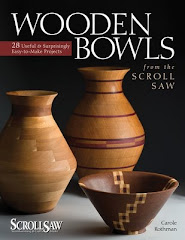While holiday ornaments are not my usual type of project, I fell into these quite by accident, and am delighted with the results. All are made from rings or discs cut at an angle, then glued and sanded as though they were bowls.
Some of the orbs contain a large jingle bell, others are just decorative. The insides of the orbs can be made into shaped ornaments, or the shaped ornaments can be made as a separate project.
Instructions for the orbs, with and without bells, are available in the November/December 2018 issue of Woodworker's Journal, and instructions for the shaped ornaments are in the Holiday 2018 issue of Scroll Saw Woodworking & Crafts. They are both great ways to make maximum use of colorful scraps of hardwood and veneer.
Showing posts with label angled cutting. Show all posts
Showing posts with label angled cutting. Show all posts
Wednesday, November 21, 2018
Saturday, January 8, 2011
Cutting precise angles
While I'm waiting for the weather to warm up a bit so I can get back into the garage without sending my pension check directly to the utilities company, I thought I'd use the time to post some hints that may have slipped through the cracks (in a manner of speaking).
Whether you're making a straight or angled cut, the first step is always to make sure that your saw table and blade are at right angles to each other. I like to use a small engineer's square, and hold it right next to the blade to see if it's parallel. If it's not "spot on", I loosen the knob that sets the angle, and tap the table gently until it's right. You'd be surprised at the precision of this non-technical approach.
Some people make a shallow cut into piece of wood, then see if the back of the blade will fit precisely into the slot. If you do this, use a blade with a very small kerf or you can "fudge" your results. However you determine square, tighten the adjusting knob so it can't slip, and move the gauge, if necessary, so it is set to zero. Sometimes this is done by loosening a screw, other times by moving the label. Now you can use the gauge with some confidence, although a quick check is never a bad idea.
Once you've set the table properly, you can use the saw's gauge, or a magnetic angle gauge, to set the cutting angle. And if you do angle cutting, always reset your table to zero when you've finished. Of course you'll notice large table tilts, but a tilt of 2 or 3 degrees may not be apparent if you're not expecting it, and can really mess up your straight cuts.
Labels:
angled cutting,
engineer's square,
scroll saw
Subscribe to:
Posts (Atom)





